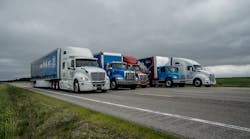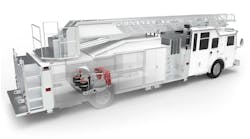Driveline and chassis technology company ZF Group recently hosted the Fleet Forum ride and drive event at the Transportation Research Center (TRC) in East Liberty, Ohio, to demonstrate the applications of various systems and technologies in commercial vehicles. Among those displayed at the event were the ZF PowerLine 8-speed torque converter automatic transmission, ReAX adaptive steering system, ReAX-e full electric steering gear, full autonomous driving through redundant ReAX and ProAI system integration, and OnTraX Lane Keep Assist and Lane Change Assist.
The event began with presentations from project managers of the various systems introducing the attendees to the ZF Group’s initiative and design of the products to be demonstrated.
Kent Jones, vice president of North American sales, introduced ZF’s Vision Zero – a goal of zero emissions and zero accidents. Jones also addressed the profound changes in the transportation industry, being automation, electrification, and digitalization – all of which ZF is directly addressing through the development of their product portfolio.
Dan Williams, director of ADAS and autonomy, laid out ZF’s dual path development strategy, which aims to utilize both a revolutionary and an evolutionary approach. Their revolutionary approach can be best understood as the “unveiling of the product” that was produced behind the curtains, such as the corporate central safety domain electronic control unit (ECU), a graphics processing unit (GPU) based central computer with an artificial intelligence (AI) environmental model and deep learning algorithms. The evolutionary approach can be seen through the progression of products’ standing in SAE levels of automation. A product developed and designated Level 1 status is then built upon or combined with another product or system to continue up the chain in levels of automation, one step at a time. Implementing both approaches serves the commercial vehicle industry in terms of available options and flexibility in adoption rate. The majority of technological developments through ZF begins in the passenger vehicle field, says Williams. Moderations and redesigns of technology are then introduced to commercial vehicle applications through base developments on other market and vehicle applications.
Product introduction details
Williams also gave overviews of the ReAX and OnTraX systems.
ReAX is an electronic control system that works in tandem with hydraulic steering. The ReAX system allows the hydraulics to “do the heavy lifting” while the system integrates precise control. At highway speeds, ReAX instills a sense of stability in the lane; while out of the lane or at low speed, ReAX allows for comfort and the ability to execute high-cut turns.
OnTraX is an active lane-keep assistance system for heavy duty commercial vehicles. It adds two more components, an S-Cam 2T Camera and a 24GHz AC100T MR Radar, to the vehicle to provide a definitive intervention zone. Used in conjunction with ReAX, OnTraX assists the driver through the provision of a continuous and consistent steering experience, implementing interventions only when the vehicle nears the edge of a lane.
OnTraX also features Lane Change Assist, with the addition of side short-range radar systems in the fairing of the truck to establish a blind spot detection zone from the front steer wheels to the rear of the trailer. OnTraX deploys a haptic warning system, through vibration of the steering wheel, to notify the driver of a collision possibility. The warning is only activated when three parameters are simultaneously present: an active turn signal, driver intention of a lane change (through an approach toward lane edge congruent with the turn signal), and a present vehicle detected within the blind spot range on the side of the vehicle designated through the turn signal and approach.
Andre Kohl, manager of business development in North America, presented the ZF PowerLine 8-speed automatic transmission. Originally produced for the passenger vehicle market, and since 2007 has had more than 15 million units introduced, this transmission was redeveloped for the commercial vehicle market. The PowerLine covers a range from Class 3 through Class 8 (baby 8) vehicles. The PowerLine has eight speeds, four gear sets, five clutches and brakes, two of which remain open, 1,000 ft-lb torque, and a GCWR of 57,000 lbs. The installation of a ZF PowerLine can eliminate the need for various parts, such as a shift selector cable, a park pawl cable, external speed sensors, harnesses, a transmission control module, and a cable shift selector, says Kohl.
Mark Cartwright, senior engineering manager, advanced engineering for commercial vehicle steering systems, showcased the ReAX-e, a proof of concept electronic power steering system for light commercial vehicles. With industry development on such systems focusing on rack and pinion design, trucks have been left behind, Cartwight says. The ReAX-e addressed this by replacing the existing hydraulic gear with an electric gear, implementing EPS without the need of a front-end redesign of the vehicle. This bolt-in technology keeps the steering independent of the drivetrain, allowing for full EV, hybrid, or combustible engine compatibility.
Demonstrations
I had the opportunity to experience these ZF technologies during the ride and drive event on closed courses at the TRC.
The first demonstration was of the ReAX backing and lot maneuver capabilities. The demonstration consisted of backing a truck, in a dogleg left pattern, up to a trailer within a route outlined by cones. The first attempt was without the ReAX system engaged on the vehicle – some cones were damaged in the process. After pulling forward and repositioning for another attempt, the ReAX system was engaged. With the system on, the steering was much more fluid, easier to execute, and far more precise. I was able to maneuver the truck through the cone-lined route without incident and could immediately notice a difference in effort and ability.
The ReAX was further demonstrated through a rough surface handling exercise, in which I drove a truck over bumps and uneven surfaces with and without the system engaged. Without ReAX active, I was required to maintain a straight line through constant adjustment of the steering wheel, as the surface dictated the direction of the steering. With the system engaged, the rough surface’s impact was mitigated and the constant minor adjustments with the steering wheel were no longer necessary.
In another demonstration I drove a light commercial vehicle with the ReAX-e system. I maneuvered the vehicle at various speed ranges, all the while with the effort levels of the system increasing as speed was increased. Driving the vehicle without ReAX-e engaged, turning the vehicle felt stiff and required exertion on my part. With ReAX-e engaged I noticed a difference in ease-of-movement and a major relief in effort. After conventional operation with the steering wheel, the controls were handed over to Mark Cartwright, as he used a panel and knob to steer the vehicle to demonstrate its fully electronic design (visit Fleet Maintenance’s Facebook page for a video of this portion of the demonstration).
The manual operation from the control panel was a physical representation of the systems that can be integrated alongside the ReAX-e, such as sensors, cameras, radars, etc. to control the steering and relay data to the system.
The PowerLine transmission was demonstrated through a two-part test in which I drove one vehicle with a comparable 8-speed automatic transmission, followed by driving a vehicle with the PowerLine. In my first drive, experience was as expected, with a slow start ability and the hesitation coinciding with obvious gear shifts. Then I drove the same model truck with a PowerLine transmission.
The first difference that intrigued me was that the vehicle, when positioned on a flat surface, started in second gear automatically. I pushed the pedal to the floor – takeoff was smooth and quick. As I sped up, I could hear the gears changing but the hesitation and familiar back-and-forth rocking motion in my seat was gone. The seamless upshifts and downshifts provided a pleasing driver experience.
Ananda Pandy, technical specialist of ADAS and autonomy, demonstrated the autonomous operation of a commercial vehicle. I rode along with Pandy as he explained the design and components that made this system possible. The vehicle was equipped with redundant steering, having ReAX installed in both the column and in the gear. A ProAI computing platform was the brains of the operation, relaying multiple datastreams to operational mechanics, as well as utilizing GPS data. The demonstration was set up as if the vehicle would be performing terminal operation – progressing through a pre-determined route with various stops, starts, and turns, as would a commercial vehicle in a yard, weigh station, wash station, etc. Pandy spoke to the capabilities of the ProAI, stating that such a computing platform could integrate with other systems such as camera, radar, and sensor data to further the precision of autonomous operation. Though the redundant ReAX installation is ready for the road, fully autonomous operation is designed with the idea that it will be deployed for terminal operation at first, following ZF’s evolutionary approach mentioned above, before autonomous commercial vehicles are sharing the roads with drivers.
The OnTraX Lane Keep Assist was demonstrated on an eight-mile loop, as I drove a truck at highway speeds and tested the system. OnTraX is engaged once the vehicle reaches 40 mph and disengages after slowing below 35 mph. Parameters for these speed ranges and the aggressiveness of the intervention can be tuned to driver or fleet needs/preferences, and during the demonstration I experienced the system at high, medium, and low intervention efforts. When driving center-lane, there is no intervention from OnTraX; as I neared the edge of the lane, in either direction, the intervention was deployed and the system re-centered the vehicle in the lane. The intervention consists of two steps: when veering out of lane, the steering is corrected back toward center lane; after the initial intervention, the secondary intervention is implemented to stabilize the vehicle in the center of the lane by steering back in the initial veer direction slightly in order to avoid over correction. The feeling of this intervention was smooth. There was no “whip” sensation from the steering adjustments, even when the system was tuned to high effort. The operation of this system is thoughtful as the driver remains in control. If there is an active turn signal, the system does not deploy intervention when veering in the direction indicated by the turn signal (however it still deploys if the vehicle veers away from the direction indicated by the turn signal). The driver can also easily override the intervention; in situations when quick lane departure is warranted or necessary, the driver is not limited in actionable movement due to intervention and can continue to veer through the intervention’s corrective adjustment with ease.
The OnTraX with Lane Change Assist was demonstrated on the same eight-mile loop; I drove the truck at 50 mph in one lane with an open lane on either side of the vehicle. A passenger vehicle was in tow and would speed up to pass along a side of the truck, or slow once ahead of me as I passed it; the OnTrax with Lane Change Assist was engaged throughout. When the vehicle would begin to pass on a side, I engaged a turn signal and approached the edge of the lane on the same side. When the vehicle was in the blind spot zone (front steer tire to rear of trailer) while my turn signal was engaged, and I approached that same lane, the steering wheel would begin to vibrate to notify me that the lane was occupied and collision was imminent. The warning was not overwhelming, but it was more than enough to alert me and allow me to change my actions to avoid collision. Whether I was passing the vehicle, the vehicle was passing me, the vehicle was directly beside the cab, or the vehicle was at the tail end of the trailer, the system recognized a possible collision and delivered an adequate warning every time.
The demonstrations were definitive examples of the technological capabilities of the various systems and the experience of operating vehicles with and without such systems provided clear understanding of how impactful they could be. ZF Group, at its Fleet Forum ride and drive event, introduced systems, some available today and others on the horizon, to be integrated into fleets to offer adaptation to the industry’s trend in automation, electrification, and digitalization.




